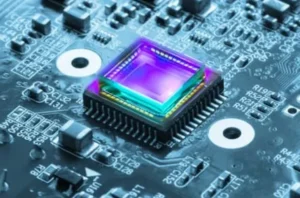
Why in news?
- The Indian government’s vision for a self-sufficient future in the semiconductor industry takes a significant step forward with the proposed establishment of a dedicated research and development (R&D) unit under the soon-to-be-launched India Semiconductor Research Centre (ISRC).
- This strategic move signifies India’s commitment to accelerating semiconductor research and closing the gap between innovation and industrial production.
Bridging the Gap Between Semiconductor Research and Production
- The proposed R&D wing within the ISRC will carve a distinct path.
- Unlike existing research frameworks, it will prioritize rapid development cycles, ensuring that research findings swiftly translate into practical applications for semiconductor production.
- This focus on swift commercialization holds immense value in a dynamic industry like semiconductors.
Funding the Future: Public-Private Partnerships and Beyond
- The government is exploring various funding mechanisms to fuel this R&D powerhouse.
- Public-private partnerships (PPPs) are a frontrunner, fostering collaboration and knowledge exchange between academia and industry.
- Additionally, co-funded arrangements are on the table, potentially attracting significant investment and expertise from both national and international players.
Intellectual Property: Owning Innovation
- A cornerstone of this initiative is the emphasis on creating intellectual property rights (IPR) within this sector.
- This focus on homegrown innovation is crucial for India to establish itself as a leader in chip design, fabrication, and other critical segments of the semiconductor value chain.
- Strong IPR safeguards India’s technological advancements and empowers the nation to compete effectively in the global market.
Research Focus: Pushing the Boundaries
- The ISRC’s R&D unit will spearhead research on cutting-edge semiconductor technologies.
- Key areas of focus include next-generation chip designs, advanced packaging solutions, innovative system technologies, and the development of novel materials and processes.
- This comprehensive approach ensures India remains at the forefront of semiconductor advancements, equipped to address the ever-evolving needs of the electronics industry.
Building a Strong Foundation: Education Matters
- The government recognizes the importance of a robust academic ecosystem to nurture future generations of semiconductor experts.
- Initiatives are planned to strengthen the academic infrastructure related to semiconductors, potentially introducing specialized undergraduate and postgraduate courses.
- This will equip future engineers and researchers with the necessary knowledge and skills to lead India’s journey towards semiconductor self-reliance.
Leveraging Top Institutions: Collaboration is Key
- India boasts a wealth of intellectual capital within its premier educational institutions.
- Top institutions like the Indian Institutes of Technology (IIT) Bombay, IIT Gandhinagar, and the Indian Institute of Science (IISc) Bengaluru are envisioned to play a pivotal role.
- These institutions harbor exceptional research talent and advanced facilities, making them ideal partners in propelling domestic semiconductor R&D and education.
Conclusion
- While details of this initiative are expected to be finalized after the June general elections, the proposed R&D unit under the ISRC presents a promising future for India’s semiconductor ambitions.
- The possibility of the R&D unit evolving into an independent entity further underscores the government’s unwavering commitment to building a robust domestic semiconductor industry.
- By fostering rapid research translation, attracting diverse funding streams, and prioritizing IPR creation, India is poised to make significant strides towards achieving self-reliance in this critical technology sector.
- The combined efforts of government, academia, and industry hold the key to unlocking India’s potential as a global semiconductor powerhouse.
People also ask
Q1: What is the goal of the proposed R&D unit under the ISRC?
Ans: The primary goal is to speed up chip research and development (R&D) in India, ultimately leading to domestic chip production and reduced reliance on imported chips.
Q2: How will the R&D unit differ from existing research frameworks?
Ans: Unlike traditional research, this unit will focus on getting research findings into practical use for chip manufacturing much faster.
Q3: What funding mechanisms are being considered for the R&D unit?
Ans: Public-private partnerships (PPPs) are a top option, fostering collaboration between the chip industry and academia. Additionally, co-funded arrangements with national and international players are being explored to attract investment and expertise in chip technology.
Thanks for sharing. I read many of your blog posts, cool, your blog is very good.
Thanks for sharing. I read many of your blog posts, cool, your blog is very good.